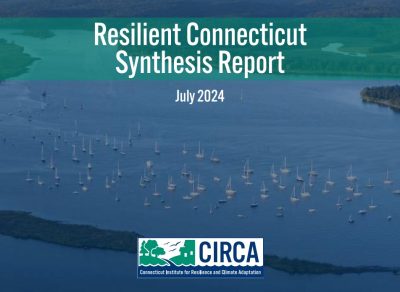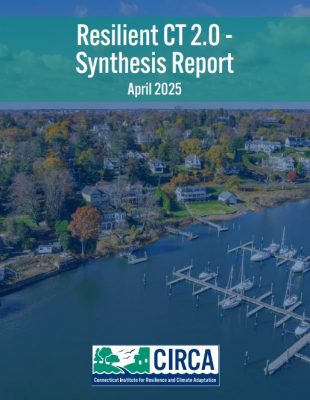Resilient Connecticut 1.0 Synthesis Report
 The Resilient Connecticut 1.0 Synthesis Report is a comprehensive document which summarizes and “synthesizes” the planning process in Fairfield and New Haven Counties. This planning process was initiated through a grant from the HUD sponsored National Disaster Resilience Competition following Superstorm Sandy. The State of Connecticut through a partnership of state agencies known as the State Agencies Fostering Resilience or SAFR, submitted a successful proposal to the NDRC and received funding to implement pilot projects in the South End of Bridgeport (Resilient Bridgeport), as well as funding to extend planning opportunities to other communities in Fairfield and New Haven Counties that were impacted by Sandy. This planning process is called Resilient Connecticut. For more background information about the NDRC grant please visit the CT Department of Housing page.
The Resilient Connecticut 1.0 Synthesis Report is a comprehensive document which summarizes and “synthesizes” the planning process in Fairfield and New Haven Counties. This planning process was initiated through a grant from the HUD sponsored National Disaster Resilience Competition following Superstorm Sandy. The State of Connecticut through a partnership of state agencies known as the State Agencies Fostering Resilience or SAFR, submitted a successful proposal to the NDRC and received funding to implement pilot projects in the South End of Bridgeport (Resilient Bridgeport), as well as funding to extend planning opportunities to other communities in Fairfield and New Haven Counties that were impacted by Sandy. This planning process is called Resilient Connecticut. For more background information about the NDRC grant please visit the CT Department of Housing page.
The 1.0 Synthesis Report summarizes the different phases of the regional plan development across the 2-county study area (Phase II), as well as local and site plans that were developed in Phase III. In addition, technical support and “capacity building” activities were funded through the grant including the development of high-resolution flood modeling and 2050 risk maps, UConn faculty sponsored research activities, and a public engagement and tool-kit development program. Summary information about support and capacity building activities can be found in the Synthesis Report Appendices listed below. These include fact sheets, white papers, map viewers, and other tools which help to support local and regional resilience planning in Connecticut.
Section 5 of the 1.0 Synthesis Report includes lessons learned and policy recommendations for a resilience road map for Connecticut. These recommendations are informed by what we learned over the course of developing Resilient Connecticut and can provide a pathway forward for the state as we continue to experience the impacts of climate change.
Individual Appendix Files can be downloaded below:
Appendix A - Support Activities
Appendix B – Map Viewers
Appendix C - Zoning Library
Appendix D – Extreme Heat Toolkits
Appendix E – Fact Sheets and Case Studies
Appendix F – White Papers
Appendix H - Resilient South Norwalk Adaptation Options Final Report
Appendix I – Resilient Fairfield Adaptation Options Final Report
Appendix J - Resilient Ansonia Adaptation Options Final Report
Appendix K – Resilient Stratford South End Adaptation Options Final Report
Appendix L – Resilient Fair Haven Adaptation Options Final Report
Appendix M – Resilient Meadow Street Adaptation Options Final Report
Resilient Connecticut 2.0 Synthesis Report

The Resilient Connecticut 2.0 Synthesis Report summarizes the expansion of the Resilient Connecticut program through the regions associated with the Lower Connecticut River Valley Council of Governments (RiverCOG), the Southeastern Connecticut Council of Governments (SECOG), and the Capitol Region Council of Governments (CRCOG). This work was supported by the State of Connecticut as well as the Federal Emergency Management Agency, with the goal of facilitating resilience planning for Connecticut municipalities and identifying projects for the state resilience project pipeline.
The report provides an overview of the Resilient Connecticut 2.0 regions of focus, summarizes the regional vulnerability assessment conducted by CIRCA across the three COGs (Phase II), and highlights the local and site plans that were developed in Phase III. The report appendices listed below include a summary of CIRCA engagement with each municipality in the 2.0 project area, documentation of the GIS methodology for the vulnerability assessment, inventories of data resources including the Zones of Shared Risk (ZSRs), Resilience Opportunity Areas (ROARs), and the Climate Change Vulnerability Index, as well as summaries of supporting activities such as heat sensor and flood sensor deployment, municipal grants, and other resources to support local and regional resilience planning in Connecticut.
Individual Appendix Files can be downloaded below:
Appendix A - Inventory of CIRCA Town Engagement
Appendix B – GIS Analysis Methodology
Appendix C - Zones of Shared Risk Inventory
Appendix D – Climate Change Vulnerability Index (CCVI) Resources